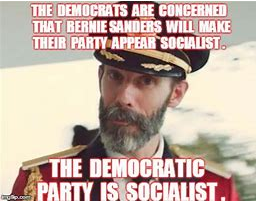 Democrat Party stance and high profile sponsorship
Democrat Party stance and high profile sponsorship- The narcissism of socialists – the managed society with the movers and shakers as the mangers of course – and the child-like acceptance
- The costs of just their health care takeover*
Democrat Socialists and Their Single-Payer Healthcare Agenda (Townhall excerpt)
This appears to be the direction that the Democratic National Committee is going, as  their deputy chair, Keith Ellison, has assumed the lead sponsor role of this bill. However, the Democratic Congressional Campaign Committee commissioned a survey which reveals that only 12% of Americans want single payer healthcare. Candidates have been warned to be careful how they message this without damaging their electability. They have been given talking points to help them hide their true intentions.
their deputy chair, Keith Ellison, has assumed the lead sponsor role of this bill. However, the Democratic Congressional Campaign Committee commissioned a survey which reveals that only 12% of Americans want single payer healthcare. Candidates have been warned to be careful how they message this without damaging their electability. They have been given talking points to help them hide their true intentions.
Single payer healthcare has always been a central feature of every socialist regime around the world. It sounds so wonderful and irresistible that only the most horrible of individuals would reject these Democratic Socialist proposals. Who would not like to see comprehensive medical coverage for everyone in the US? This plan would be free to all, including non-citizens, and provide free care without copays, deductibles or premiums. It would also include a jobs initiative and severance for those affected by transitioning to a government run healthcare system. And best of all, it would be paid for through increased taxes, predominantly on the “rich.”
This idea is ludicrous in so many ways but today when crazy has become mainstream, people need to understand how misguided it is and reject it. There are many reasons to do so but it may be best to focus on cost.
We cannot afford a single payer healthcare system. Sanders claims that his system would cost $1.4T and could be paid for by increasing federal taxes 2.2% and levying a 6.2% surcharge on employers. This is nonsense and fantasy. A single payer system controls costs by rationing care and paying doctors less to provide it. Price controls like copays on employer based health plans and Medicare Part B would disappear and demand for care would soar. Emory healthcare economist Ken Thorpe estimates that this system would cost taxpayers $2.5T every year in new taxes and the Urban Institute estimates that the Sanders proposal would cost $32T by 2026, which means $24K in higher taxes for every household in America.
http://humanevents.com/2012/01/21/the-narcissism-of-liberalism/
No retreat, full speed ahead. Note this 2012 analysis,
The narcissism of liberalism (Human Events excerpts)
The Occupy Wall Street movement is the epitome of the narcissism of liberalism. Its cacophony of causes may seem incoherent, but it is unwittingly articulate in describing America’s Left. It gives unfiltered voice to the conflicting agendas, the limitless demands, and the proposals without end points that liberals continually espouse, but for which they are rarely held accountable. . . .
They want to redistribute what they consider to be the nation’s malapportioned wealth. Yet they are peopled by those who apparently can afford prolonged time away from earning a living. And in this exercise in extended urban excursion, they claim to speak for those who are struggling to make ends meet.
Obviously, their plans are wholly dependent on the wealthy. They need plutocrats to fund their programs, to produce the wealth necessary to pay for their good intentions—and produce it in copious quantities.
These inconsistencies are beside the point, because they aren’t Occupy’s point in the first place. Occupy’s real end—not simply its means—is about focusing attention on itself. It is the very embodiment of narcissism.
. . .
Because those on the Left see economic forces as illegitimate, there is nothing the market does that the political state cannot somehow improve. . . . .
Liberalism has come to espouse using someone else’s resources to realize its ends. The left hand of the Left forever extends into the right pocket of America. And because others foot their bills, there is no cost liberals are not willing for others to bear—so there can always be another program, another goal to be reached.
Their key players have all bought into this
New Study Shows Huge Cost of Sanders’ ‘Medicare for All’ Plan (Heritage Foundation article)
 Socialism is expensive. In a new cost analysis, Charles Blahous, formerly a member of the Medicare board of trustees, concludes that Vermont Sen. Bernie Sanders’ “Medicare for All” bill (S. 1804) would cost a breathtaking $32.6 trillion over 10 years.
Socialism is expensive. In a new cost analysis, Charles Blahous, formerly a member of the Medicare board of trustees, concludes that Vermont Sen. Bernie Sanders’ “Medicare for All” bill (S. 1804) would cost a breathtaking $32.6 trillion over 10 years.
Given the growing commitment of House and Senate Democrats to this agenda, Blahous’ analysis is timely. His assessment of the federal government’s financial burden is also consistent with two other independent analyses.
Two years ago, the Urban Institute, a highly respected liberal think tank, estimated the total cost of the Sanders proposal at $32 trillion over 10 years, and professor Kenneth Thorpe of Emory University, a former adviser to President Bill Clinton, estimated the cost at $24.7 trillion.
In both cases, the analysts estimated that the level of taxpayer funding would be much higher than Sanders and his colleagues assumed.
Central Control
Co-sponsored by 16 leading Senate Democrats—including Sens. Kamala Harris of California, Elizabeth Warren of Massachusetts, and Cory Booker of New Jersey—the Sanders bill is the quintessential prescription for comprehensive government-controlled health care.
In the House of Representatives, 123 Democratic members, more than half of the House Democratic Caucus, have co-sponsored similar legislation (H.R. 676).
The Sanders bill would create a national health insurance program; prohibit all Americans from having a private or employer-based health insurance plan; and abolish Medicare and Medicaid, absorbing their functions into the new national health insurance scheme.
The bill would mandate that doctors, hospitals, and medical professionals be paid Medicare payment rates, and would restrict private agreements between doctors and patients outside of the national system.
Bottom Line
The $32.6 trillion in additional federal spending (2022 to 2031) alone would equal 10.7 percent of the national economy, as measured by the gross domestic product, and would rise to 12.7 percent of GDP by 2031.
Blahous grants Sanders and his Senate co-sponsors the benefit of the doubt. His estimates assume that their bill would be successful in reducing revenues going to doctors, hospitals, and other medical professionals. He also assumes that their legislation would achieve its goals of reducing the cost of prescription drugs as well as administrative costs.
Blahous cautions, however, that drugs account for only 10 percent of total national health expenditures, and the bill’s intention to replace brand names with generics would take effect within a market where generics already make up 85 percent of drugs sold.
Uncertain Savings
Concerning administrative costs, the replacement of private insurance with a single government program would, in theory, secure major administrative cost reductions. For the sake of his estimates, Blahous projects a substantial 7 percent reduction in administrative costs.
There are, he warns, methodological problems in simple comparisons between Medicare and private-sector administrative costs.
Moreover, the major government programs are plagued by persistent administrative failures that routinely jack up administrative costs. Medicare and Medicaid, for example, racked up an estimated $96 billion in improper payments in 2016 alone.
“Although government also polices fraud within its health insurance programs,” Blahous observes, “financial survival and business competitiveness are concerns from which government-provided insurance is generally exempt.”
Even assuming gains from reductions in administrative costs, drugs, and the big reductions in provider payments, other features of the legislation, such as the abolition of all cost-sharing, would drive the costs of the program upward.
Huge Taxes
Taxpayers would face enormous burdens, assuming Congress enacted and the president signed the Sanders bill. In his earlier analysis, Thorpe estimated that those taxes would amount to 20 percent of payroll, and roughly 70 percent of working households would pay more than they do today.
For his part, Blahous says that the costs would be such that “doubling all federal individual and corporate income taxes going forward would be insufficient to fully finance the plan, even under the assumption that provider payment rates are reduced by over 40 percent for treatment of patients now covered by private insurance. Such an increase in the scope of the federal government operations would precipitate a correspondingly large increase in federal taxation or debt and would be unprecedented if undertaken as an enduring commitment.”
The promise of “something for nothing” is always appealing, but it’s never cheap.
*Memes not in original articles
